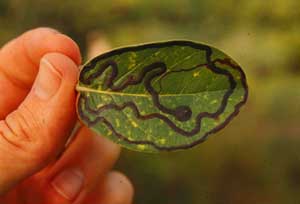|
|
 68 inducible defenses DHJanzen100306.jpg high resolution
|
|
| To this point in this brief overview I have spoken of secondary compound defenses as relatively static - compounds that are stored in the tissues of the plant and therefore encountered when the herbivore chews into the plant. But plants, like any defense system, have passive and inducible components. In this Costa Rican Byrsonima leaf photographed by Larry Gilbert, a leaf-mining beetle larva (Buprestidae) has mined through the leaf tissues, leaving behind a tunnel full of frass (turds and food fragments). The plant has then reacted to it by depositing massive amounts of tannins (the brown color) in the walls of the cells bordering the tunnel. This produces a wall of tannin blocking invasion of healthy plant tissues by fungi and bacteria. | ||
back to lecture slides
or skip to: